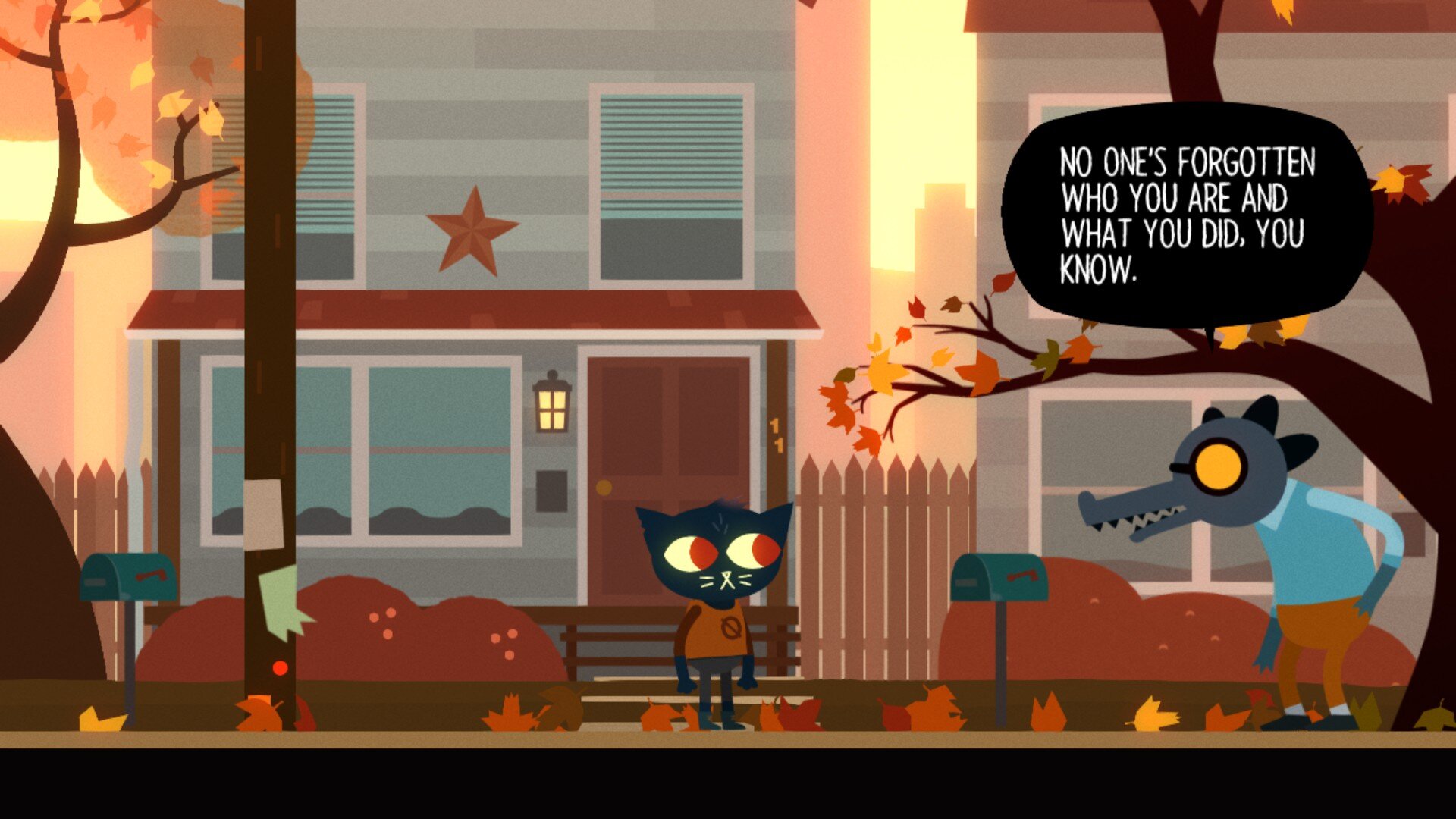Night in the Woods
Until the final chapter of Night in the Woods, I was convinced I was going to give it a rapturous review. The game follows the daily life of Mae, a girl who just dropped out of college for reasons unmentioned and returned to her small hometown. It's mostly a slice-of-life visual-novel-with-minigames, as you explore the slowly dying town, reconnect with Mae's friends, explore her relationship with her parents, and have Mae try to recover from whatever happened at college and find her place at home again.
The game has so many things to recommend it. It's witty and poignant. The dialogue feels real, the friendships genuine, the heartbreak heartaching. And the animation is pretty darn pretty too. One of the game's main themes is the dying town -- all the stores are closing, the young people are leaving, and opportunity is vanishing bit by bit. This is a town with no cell phone service, because no one considers it worth building the infrastructure. It's a place where there's only one doctor, and he does everything from offering therapy to removing teeth.
And although the game was in development before the 2016 elections, a lot of its small town themes feel particularly relevant now. The older people in this dying town are resentful of the big cities and big businesses that are killing their home, and there's a quite on-the-nose story thread about sacrificing those less noticed by society in order to protect their own way of life a little bit longer. They don't like doing it, but they will do it, because they see it as necessary for survival.
But the most poignant part, to me, was the gradual exploration of Mae's depression. Mae, we learn as the story unfolds, suffers from disassociation and anxiety so bad that she was unable to leave her dorm room in college and finally came home to where things are safe and familiar, only to find that things aren't so safe and familiar, because the town is dying, the people she loves are leaving, and there are no opportunities for her here. Her parents spent all their money making her the first person in the family to go to college, and now she's back, feeling a failure, struggling with nightmares and anger issues, completely lost about what to do next.
Night in the Woods is most affecting in its quiet moments. It's talking to one character about how he blamed himself for his childhood abuse. It's walking in the graveyard with another character, who has come to visit her mom's grave. It's the heartbreak of Mae's best friend planning to move to another town with his boyfriend, leaving Mae not knowing where she fits into his life.
And although Night in the Woods is something of a decision-based game, in that you can choose what to say and who you talk to and which friendships to build, many bad decisions are out of your hands. You can't stop Mae from being self-destructive, perhaps because, due to her illness, she can't stop herself either.
But then we get into deep spoiler territory, where all that emotional exploration seems undercut by the supernatural.
Throughout the game, Mae is convinced that she's seen a ghost in town, and as her nightmares get weirder, she convinces her friends to help her investigate. The answer is... unexpected. Seriously, seriously unexpected. (And I'm digging into the big spoilers from here on out). Throughout the game, it seems likely that something bad is going on. After all, you don't find an arm on the street for no reason. But I fully expected that Mae's supernatural interpretation of events was a result of her struggling to come to terms with her mental illness and creating an enemy to fight, rather than an actual supernatural entity. The actual answer, that there's a cult in town that has been sacrificing people to a god-like entity in the mines in order to keep the town alive and prosperous, leads to a frightening and gripping sequence that fits well with many of the game's themes, but, with so many questions left unanswered, it also undercuts that previous realistic story of mental illness.
It all seems too real, and seen by too any people, to be imaginary, unless of course the cultists are all delusional and Mae latches onto their story to explain her own struggles. If that is the case, I don't think the game provides enough evidence for it. There's a scrap of old newspaper talking about a gas leak at the old mines, but that's about it. And if we take the god explanation as real, we have a really sensitive, wonderful exploration of mental illness that throws in the revelation at the end that actually it's not real mental illness. It was all caused by this god, refusing to let Mae leave town. Unless it wasn't, and the god is just a metaphor for Mae's struggles. But then why do the cultists all know about it? What is she hearing in the mines? It's ambiguous, and the game is too concerned with its theme of "life continues on" to provide any hints at answers.
So now I don't know what to make of the game. I really love it for all those other elements, but one of the best themes of the game may also be the worst, depending on what the game intended and how you interpret it.
